Qué es el arte
sino aquello por lo cual
las formas devienen estilo
y qué es el estilo
sino el hombre
Jean-Luc Godard (1978)
Saludos afectuosos a la comunidad de Humanitas y a todos los amantes del cine. Esta es mi participación en "Temas para cada día (Julio)" presentados por @eudemo. Hoy toca cine y artes audiovisuales.
Invito a participar en "Temas para cada día" a @cositav @helicreamarket @yeral-diaz @mariiale1979 @capitandelbam @karelysk89 (si tienes tiempo allá por deonde estés) @robotgirl2024 @edith-4angelseu @nabu.doconosor2 y @sacra97 (me gustraría leerte por aquí).
Invito y saludo muy especialmente a mi amigo @soho1958, con la seguridad de que sus creaciones van a sumar más valor a la Colmena.
El cine, ese arte que consta de imágenes que dan la apariencia de movimiento, es seguramente una de las expresiones artísticas más populares. Modelador de conciencias, creador de modas, de estereotipos, medio de diversión, difusor de valores, medio de propaganda, etc., también ha sido, un portador de interrogantes existenciales.
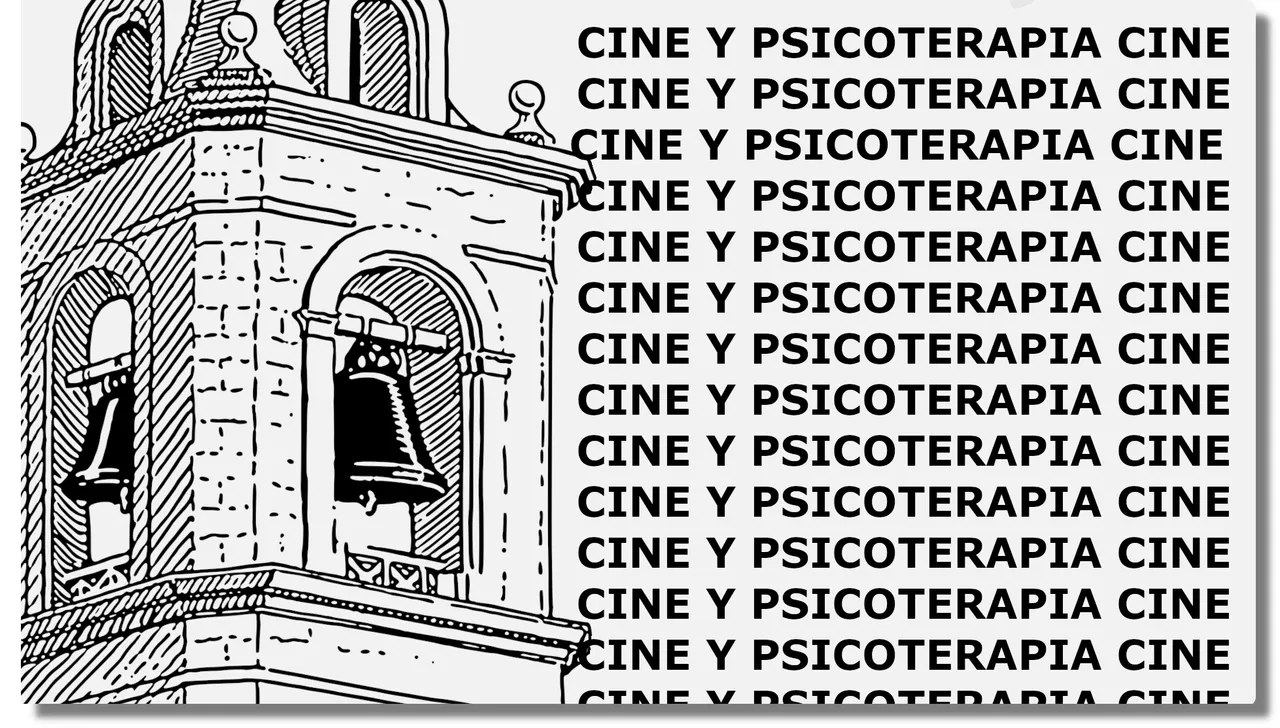

What is art
but that by which
forms become style
and what is style
but man
Jean-Luc Godard (1978)
Warm greetings to the Humanitas community and to all film lovers.This is my participation in "Temas para cada día (July)", today it's time for cinema and audiovisual arts.
I invite to participate in "Topics for every day" submitted by @eudemo to @cositav @helicreamarke @yeral-diaz @mariiale1979 @capitandelbam @karelysk89 (if you have time) @robotgirl2024 @Edith-4angelseu @nabu.doconosor2 and @sacra97 (I'd like to read you around).
And I especially invite and greet my friend @soho1958, with the certainty that his creations will add more value to Hive.
Cinema, that art that consists of images that give the appearance of movement, is surely one of the most popular artistic expressions. As a shaper of consciences, creator of fashions and stereotypes, a means of entertainment, a disseminator of values, a means of propaganda, etc., it has also been a bearer of existential questions.

La relación del cine con la psicología (psicoterapia) puede ser variada. Hay obras que que se oponen de forma crítica, casi militante, a las instituciones de salud mental como Alguien voló sobre el nido del cuco (1975) o documentales como Monos como Becky (1999). Películas en las que se toma ferviente partido por el “enfermo” mental. En otro extremo podemos encontrar las películas que refuerzan la errónea creencia que asocia la “enfermedad mental” con el acto violento.
Sin embargo, sin aludir directamente a la “enfermedad mental”, en el cine, como en la literatura, también cabe la reflexión sobre nuestros propios conflictos, nuestra existencia y nuestros temas fundamentales: la búsqueda de la identidad, el amor, la pérdida, la muerte y el renacimiento.
Campanadas a media noche
Hoy trataré de abordar desde el campo de la psicología (psicoterapia) una de esas películas, que aludiendo a nuestros temas universales, me sigue conmoviendo cada vez que la vuelvo a visitar. Y, esta película, no es otra que “Campanadas a media noche” (1965) de Orson Wells.
El personaje que protagoniza esta historia es Sir John Falstaff, un personaje tomado del imaginario de William Shakespeare.

The relationship between cinema and psychology (psychotherapy) can be varied. There are works that critically, almost militantly, oppose mental health institutions, such as Someone Flew Over the Cuckoo's Nest (1975) or documentaries such as Monos como Becky (1999). Films that fervently take the side of the mentally "sick". At the other extreme we can find films that reinforce the erroneous belief that associates "mental illness" with the violent act.
However, without directly alluding to "mental illness", in cinema, as in literature, there is also room for reflection on our own conflicts, our existence and our fundamental themes: the search for identity, love, loss, death and rebirth.
Chimes at Mindnight
Today I will try to approach from the field of psychology (psychotherapy) one of those movies, which alluding to our universal themes, continues to move me every time I revisit it. And, this film is none other than *"Chimes at Midnight"+ (1965) by Orson Wells.
The character that stars in this story is Sir John Falstaff, a character taken from William Shakespeare's imaginary.
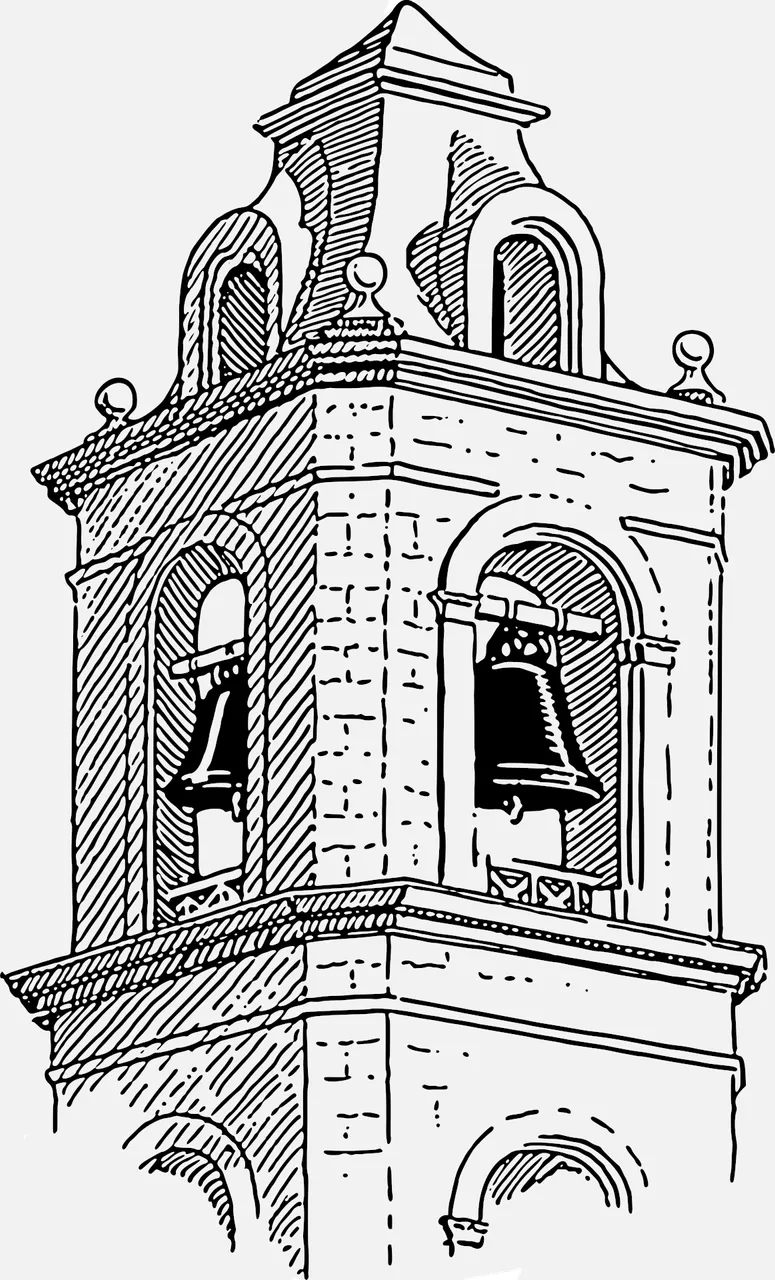

FICHA TÉCNICA
Nacionalidad: España/Suiza.
Productor: Emiliano Piedra, Angel Escolano.
Producción: International Films Española (Madrid), Alpine Film Productions (Basilea).
Guión: Orson Welles según Ricardo II,Enrique IV, Enrique V, Las alegres comadres de Windsor de William Shakespeare y The chronicles of England de Raphael Holinshed.
Dirección de Fotografía: Alejandro Ulloa
Música: Alberto Lavagnino.
Dirección artística: José Antonio de la Guerra.
Montaje: Fritz Mueller, Elena Jaumandreu.
Intérpretes principales: Orson Welles (Falstaff), Keith Baxter (Principe Hal), John Gielgud (Enrique IV).
Género: histórico
TRAMA:
Trama general o fondo histórico. Enrique IV llega al trono de Inglaterra (s.XV) de forma ilegítima tras el asesinato del regente Ricardo II. El heredero legítimo, Edmund Mortimer, es hecho prisionero por Enrique IV. Los familiares de Edmund Mortimer conspiran para derrocar al nuevo rey, Enrique IV.
Trama particular: Hal, interpretado por Keith Baxter, Príncipe de Gales y heredero del usurpador Enrique IV, se pasa el día en tabernas acompañado de Falstaff,
Falstaff, interpretado por Orson Wells, es un pícaro alcohólico que vive la vida sin la preocupación del futuro, entre juerga y juerga.
El título de Campanadas…, precisamente viene dado por la vida nocturna del personaje, sólo las personas que no duermen en la madrugada oyen las campanadas de media noche.
El rey, interpretado por John Gielgud, es un padre decepcionado con su hijo, testigo de como su heredero ha tomado como un segundo padre a Falstaff.
Orson wells nos dice que esta obra trata sobre la traición y trata sobre ella. Pero la película trata más temáticas.
Falstaff, no sólo es el personaje central de la acción, es el espejo de la Corte y de la nobleza. Es un personaje que rebosa de aquellas cualidades positivas tan escasas en la Corte. La humanidad, la capacidad de amar y la capacidad de reir. Su contrario es la Corte: un lugar paupérrimo en risas, todo es serio, oscuridad y grises.
Orson Wells trata a Falstaff con comprensión, hasta con simpatía. Sus fechorías se desvanecen, no son nada, ante la crueldad de la lucha por el Poder, la frialdad y falta de humanidad que reina en la Corte. Encontrándose la vida, la alegría de vivir, las carcajadas, el amor, entre el pueblo y no entre la nobleza.
Todavía queda otra cuestión, el triángulo que forman Falstaff, el Príncipe Hal y Enrique IV, que trataremos más adelante.

TECHNICAL DATA
Nationality: Spain/Switzerland.
Producer: Emiliano Piedra, Angel Escolano.
Production: International Films Española (Madrid),Alpine Film Productions (Basel).
Screenplay: Orson Welles based on Richard II, Henry IV, Henry V, The Merry Wives of Windsor by William Shakespeare and The Chronicles of England by Raphael Holinshed.
Cinematography: Alejandro Ulloa
Music: Alberto Lavagnino.
Art director: José Antonio de la Guerra.
Editing: Fritz Mueller, Elena Jaumandreu.
Main actors : Orson Welles (Falstaff), Keith Baxter (Prince Hal), John Gielgud (Henry IV).
GENRE: historical
PLOT:
General plot or historical background. Henry IV comes to the throne of England (fifteenth century) illegitimately after the assassination of King regent Richard II. The legitimate heir, Edmund Mortimer, is taken prisoner by Henry IV. The relatives of Edmund Mortimer heir conspire to overthrow the new king, Henry IV.
Particular plot: Hal, played by Keith Baxter, Prince of Wales and heir to the usurper Henry IV, spends the day in taverns accompanied by Falstaff,
Falstaff, played by Orson Wells, is an alcoholic rogue who lives life without worrying about the future, between binges.
The title of Chimes..., precisely comes from the character's nocturnal life, only people who do not sleep at dawn hear the chimes at midnight.
The king, played by John Gielgud, is a father disappointed with his son, witnessing how his son and heir has taken Falstaff as a second father.
Orson wells tells us that this play is about betrayal and it is about betrayal. But the film is about more than that.
Falstaff, is not only the central character of the action, he is the mirror of the Court and the nobility. He is a character brimming with those positive qualities so scarce at Court. His humanity, his capacity to love and his capacity to laugh. Its opposite is the Court: a very poor place in laughter, everything is serious,darkness and grays.
Orson Wells treats Falstaff with understanding, even sympathy. His misdeeds fade away, they are nothing, before the cruelty of the power struggles, the coldness and lack of humanity that reigns in the Court. Life, joie de vivre, laughter, love are found among the people and not among the nobility.
There is still another issue, the triangle formed by Falstaff, Prince Hal and Henry IV, which we will deal with later.

Sobre campanadas a media noche
La primera vez que vi Campanadas a Media Noche debía de tener unos 16 años. Recuerdo, que en el segundo canal de la televisión pública española emitían todas las semanas, de madrugada, algún ciclo de cine sobre algún director o estudio de esos que, para un chaval de esa edad, estaban repletos de misterio y emoción.
No todo eran películas para cinéfilos eruditos, en esas madrugadas también pude disfrutar de Boris Karloff, de Christopher Lee o de Peter Cushing, entretenerme con las producciones de la Hammer, o alucinar con la estética de películas como el Gato Negro (1936) . Y lo más importante, comentar al día siguiente, con otros dos locos, lo que habíamos visto la noche anterior (si había que saltarse alguna clase se saltaba, pues lo importante era lo importante).
Debió de ser en uno de estos ciclos temáticos sobre el séptimo arte cuando me encontré con *Campanadas a Media Noche *y, desde entonces, cada uno o dos años nos volvemos a encontrar. Puedo decir que soy un enamorado de esta película. Un enamorado de Orson Wells, junto a campanadas, La Dama de Shangai y Sed de Mal me siguen fascinando, son tres obras de arte monumentales (según mi criterio, claro).
La obra (Campanadas a Media Noche) toma como base varias obras y personajes de William Shakespeare. El proyecto fue rodado en su totalidad en España. Orson Wells no encontró ninguna gran productora que quisiera financiar este proyecto.
Primero aparecieron unos capitalistas yugoslavos, que parecía que podían tener algún interés en apoyar la idea de Wells. Éstos, igual que aparecieron se esfumaron. Finalmente, tras una serie de casualidades, el productor español Emiliano Piedra acabaría asumiendo la producción de la obra. El acuerdo incluía rodar una segunda película más comercial, La Isla del Tesoro, con la esperanza de recoger en taquilla el dinero que no daría Campanadas a Media Noche.
La película, en principio pensada en color, se rueda en blanco y negro por la falta de presupuesto, y, la verdad, una vez disfrutada es difícil imaginársela en otro formato que no sea el blanco y negro. Los encuadres de cada escena, los contrastes de luz, la fotografía de Alejandro Ulloa tiene una una capacidad de transmitir emociones increíble.
Finalizar la película fue toda una proeza, propia de los que creen en sus metas más allá del dinero, y aquí van algunos apuntes:
La batalla es memorable y, todavía, soy capaz de ver su sombra en películas como Brave Hearth (1995). Rodada en la Casa de Campo de Madrid fue rodada con unos cien extras y con palos de madera, imitando ser lanzas ya que no había presupuesto para lanzas de atrezzo.
Como alquilar un estudio no entraba dentro de las posibilidades del presupuesto de la película, se alquiló una nave industrial en el barrio obrero de Carabanchel en Madrid. Sin las ventajas técnicas de grabar en un estudio de cine (comodidad, iluminación, sonido, camerinos, etc.) las escenas de la posada fueron grabadas en esta nave industrial. La posada se convirtió posteriormente en la taberna de La Isla del Tesoro.
El rodaje en principio estaba previsto para dos semanas, pero acabó alargándose seis meses. De septiembre de 1964 hasta abril de 1965. Después, el montaje de la película duró otros seis meses con un trabajo de casi 24 horas al día durante 7 días a la semana. Y tras muchas dificultades ya teníamos película. Una magnífica película.

About chimes at midnight
The first time I saw Falstaff - Chimes at Midnight I must have been about 16 years old. I remember that the second channel of the Spanish public television broadcast every week, at dawn, a film series about some director or studio that, for a kid of that age, was full of mystery and emotion.
Not all were films for erudite cinephiles, in those early mornings I could also enjoy Boris Karloff, Christopher Lee or Peter Cushing, entertain me with Hammer productions , or hallucinate with the aesthetics of films like Black Cat (1936). And most importantly, to discuss the next day, with two other crazy people, what we had seen the night before (if we had to skip a class, we skipped it, because what was important was what was important).
It must have been in one of these thematic cycles on the seventh art when I met Falstaff - Chimes at Midnight and, since then, every one or two years we meet again. I can say that I am in love with this film. A lover of Orson Wells, along with Chimes, The Lady from Shanghai and Thirst for Evil continue to fascinate me, they are three monumental works of art (according to my criteria, of course).
The play (Chimes at Midnight) is based on several of William Shakespeare's plays and characters. The project was shot entirely in Spain. Orson Wells could not find any big production company willing to finance this project.
First some Yugoslavian capitalists appeared, who seemed to have some interest in supporting Wells' idea. As soon as they appeared, they vanished. Finally, after a series of coincidences, the Spanish producer Emiliano Piedra ended up taking on the production of the work. The agreement included shooting a second, more commercial film, Treasure Island, in the hope of collecting at the box office the money that Falstaff - Chimes at Midnight would not make.
Falstaff - Chimes at Midnight originally intended in color, was shot in black and white due to the lack of budget, and, to tell the truth, once enjoyed it is difficult to imagine it in any other format than black and white. The framing of each scene, the contrasts of light, Alejandro Ulloa's photography has an incredible capacity to transmit emotions.
Finishing the film was quite a feat, typical of those who believe in their goals beyond money, and here are some notes:
The battle is memorable and, still, I am able to see its shadow in films like Brave Hearth (1995). Shot in Madrid's Casa de Campo, it was filmed with about a hundred extras and wooden sticks, imitating spears as there was no budget for props.
Since renting a studio was not within the possibilities of the film's budget, an industrial warehouse in the working class neighborhood of Carabanchel in Madrid was rented. Without the technical advantages of shooting in a film studio (comfort, lighting, sound, dressing rooms, etc.) the scenes of the inn were shot in this industrial building. The inn later became the tavern of Treasure Island.
Filming was originally scheduled for two weeks, but ended up taking six months. From September 1964 to April 1965. After that, the editing of the film lasted another six months with a work of almost 24 hours a day for 7 days a week. And after many difficulties we had a film. A magnificent film.

Picología y cine
Algunas de las que pueden ser consideradas pseudoterapias pueden suponer beneficios contrastados para la salud de los pacientes, cuando son utilizadas correctamente por profesionales psicólogos en el marco de una adecuada relación terapeuta-paciente
Consejo General de la Psicología (2-1-2019)
Se hace necesaria esta cita del Consejo General de la Psicología (2019) de España para que nadie se asombre con lo que sigue.
Campanadas a media noche, desde el punto de vista de la psicología (psicoterapia) se la podía abordar de formas diferentes. Por ejemplo, buscando una psicopatología para cada personaje, y usar a cada uno de los personajes de ejemplos de esa etiqueta.
Podríamos haber seguido el camino ya trillado de buscar una película, como Psicosis/ Psycho (1960), y poner a Norman Bates como un modelo de trastorno de identidad disociativo. Me ha parecido más positivo seguir por otro camino.
Creo más interesante abordar el tema desde la trama, desde el conflicto del príncipe. Un conflicto universal para todo adolescente: encontrar su identidad, su lugar en el mundo de los adultos.
Desde esta visión de la trama, de la novela, y no desde la psicopatología, las marcos de referencia podían ser muchos. Desde el Freudiano y la triada edípica, en el que Falstaff podría cumplir la función de sustituto materno, el Análisis Transaccional y los guiones de vida, los ciclos vitales de Erickson, etc.
Finalmente he optado por un encuadre entre Junguiano y humanista, en el que las cartas del Tarot serán protagonistas. Por este motivo la cita del Consejo General era necesaria, hay múltiples alternativas, escuelas, técnicas que pueden ser usadas en psicoterapia. Ninguna sirve de nada si no comprendemos qué le ocurre al paciente; de la misma forma que pueden ser útiles todas si comprendemos el drama en el que habita el paciente.

Psychology and Cinema
Some of what may be considered pseudotherapies can have proven benefits for the health of patients, when used correctly by professional psychologists in the framework of a proper therapist-patient relationship.
General Council of Psychology 2-1-2019
This quote from the General Council of Psychology (2019) of Spain is necessary so that no one is astonished by what follows.
Chimes at midnight, from the point of view of psychology (psychotherapy) could be embroidered in different ways. For example, finding a psychopathology for each character, and using the characters as examples of that label.
We could have followed the well-worn path of looking for a movie, such as Psycho (1960), and using Norman Bates as a model of dissociative identity disorder. It seemed to me more positive to follow another path.
I think it is more interesting to approach the subject from the plot from the prince's conflict. A universal conflict for every adolescent: finding his identity, his place in the adult world.
From this vision of the plot, of the novel, and not from psychopathology, the frames of reference could be many. From the Freudian and the oedipal triad, in which Falstaff could fulfill the function of maternal substitute, Transactional Analysis and life scripts, Erickson's life cycles, etc.
Finally, I have opted for a framework between Jungian and humanistic, in which the Tarot cards will be the protagonists. For this reason the quote from the General Council was necessary, there are multiple alternatives, schools, techniques that can be used in psychotherapy. None of them is of any use if we do not understand what is happening to the patient, just as all of them can be useful if we understand the drama in which the patient lives.

Análisis del triángulo Falstaff, Principe Hal y Enrique IV
Hal, el Príncipe de Wales, es un adolescente rebelde, como tantos, que sólo está buscando su propia identidad, diferenciarse de los demás, también de su padre y de los mandatos paternos. En esta crisis, el joven vive en medio de dos energías opuestas, como veremos ahora.
Que nadie se asuste con lo que está por llegar.
Para analizar esta triada, hoy tomaré el auxilio de los arcanos mayores del Tarot. No como herramienta adivinadora, sino como representaciones de los arquetipos universales de los que hablaba Jung (1875-1961).
El emperador
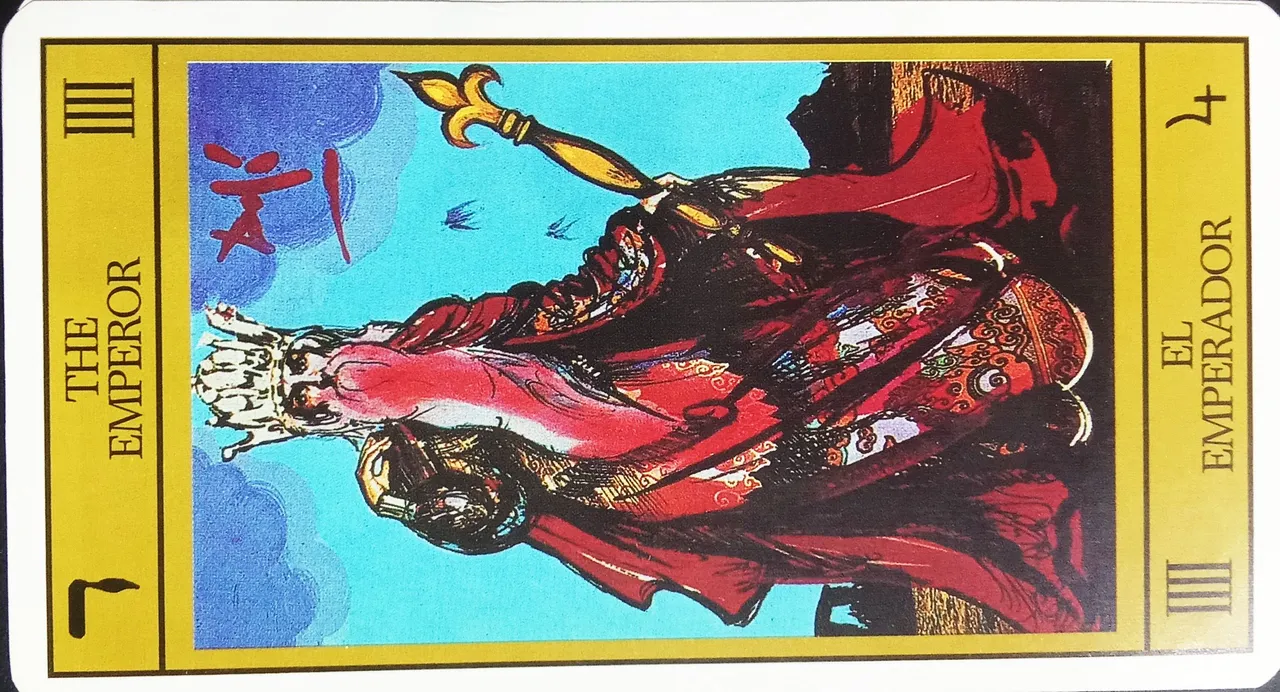
Se corresponde con el arquetipo del Padre, de la Ley. Del control de nuestras pasiones. Representa la conciencia moral. Invertido representa la vanidad, la tiranía, materialismo vulgar. Representa la necesaria demora de la satisfacción inmediata para lograr metas más altas.
Cualquier ser humano que quiera alcanzar una meta, debe de aplazar la satisfacción inmediata del deseo con el fin de lograr objetivos y satisfacciones más altas. Por ejemplo, si un estudiante quiere sacar buenas notas tendrá que sacrificar cosas que seguro que le hacen más feliz que estudiar, como salir de fiestas, para lograr su meta.
El Rey habla sobre su hijo, el Príncipe de Gales:El príncipe de Gales y yo
debemos hablar en privado
No sé si es por alguna falta
que cometí por lo que Dios quiso hacer
nacer de mi sangre el mal que dé pena a
todas mis miserias.Dime si no .¿cómo tan bajos deseos, tan
ínfimos, tan impuros placeres .tan soez sociedad, pueden
acompañar la grandeza de tu sangre?
El loco
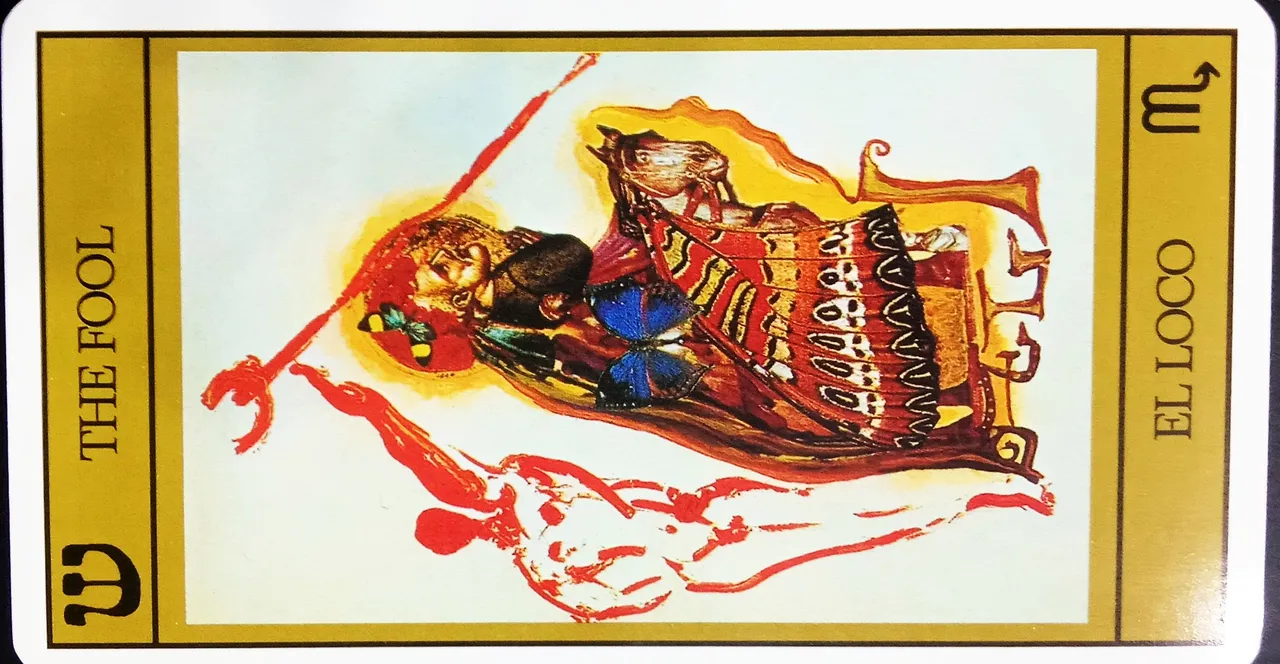
Representa la fuerza de lo inconsciente. Es la energía que nos empuja a ir más allá de de las normas, de lo establecido. Nos conecta con nuestro niño interior, con la intuición, con la curiosidad.
En su aspecto negativo indica inmadurez, dejarse llevar por la satisfacción inmediata. Es imposible conseguir nuestros sueños sin sacrificio, sin sacrificar pequeños placeres a cambio de lograr nuestras metas. Continuamos con el ejemplo de los estudios. Sin estudiar, que significa sacrificar deseos inmediatos, es imposible sacar una carrera universitaria adelante.
John Falstaff: cuando seas rey no nos dejes que nos llamen ladrones de la belleza del día, ya que de noche andamos, sino guardabosques de Diana, caballeros de la sombra, que se diga que somos gente de bien ya que como hermanos nos gobierna nuestra hermosa y casta la Luna bajo cuya cara robamos.
Los enamorados
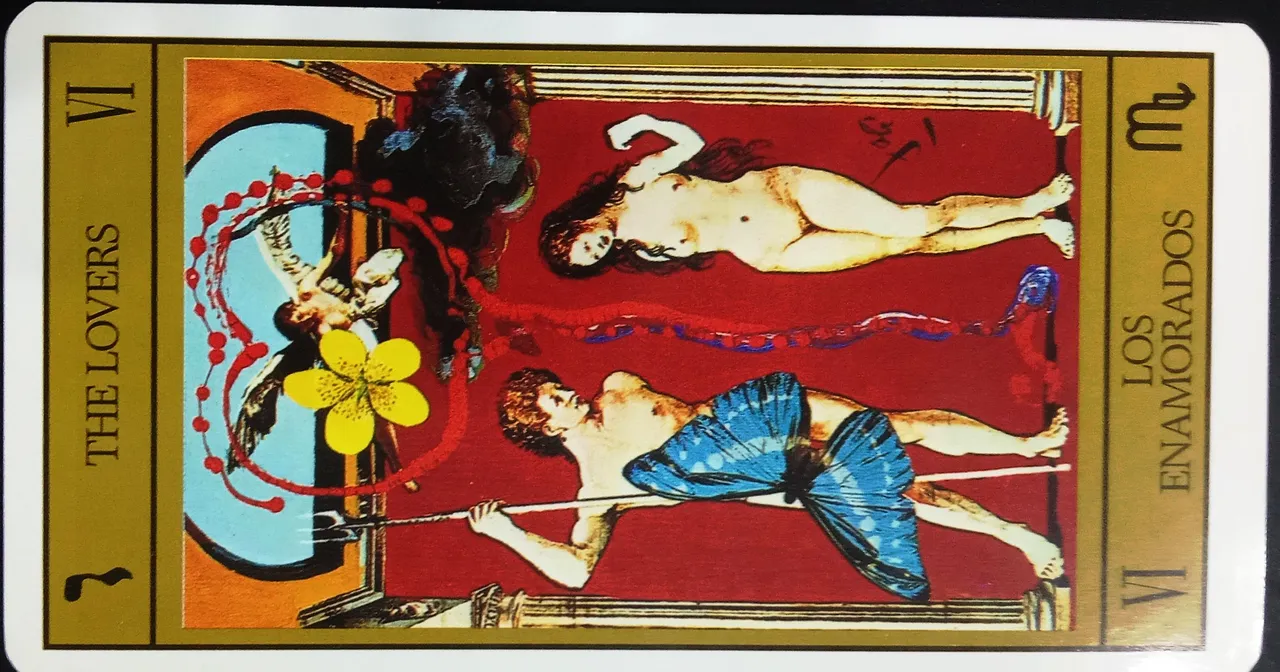
Esta carta epresenta el libre albedrío, la elección entre dos contrarios, el bien o el mal, el vicio o la virtud.
El príncipe se encuentra entre dos fuerzas y es el momento de tomar una decisión trascendental. Repetir patrones o tomar un camino propio. En este contexto, esta carta representa el encuentro con la propia identidad.
Príncipe de Gales: El día que ponga fin a este vivir alocado y pague una deuda que jamás contraje, el asombro de mis súbditos será mayor y mi reforma, tan inesperada, brillará atrayendo a todos y será más admirada que una virtud que nada hace resaltar. Mi cambio, tras mis faltas, será más meritorio.
La muerte
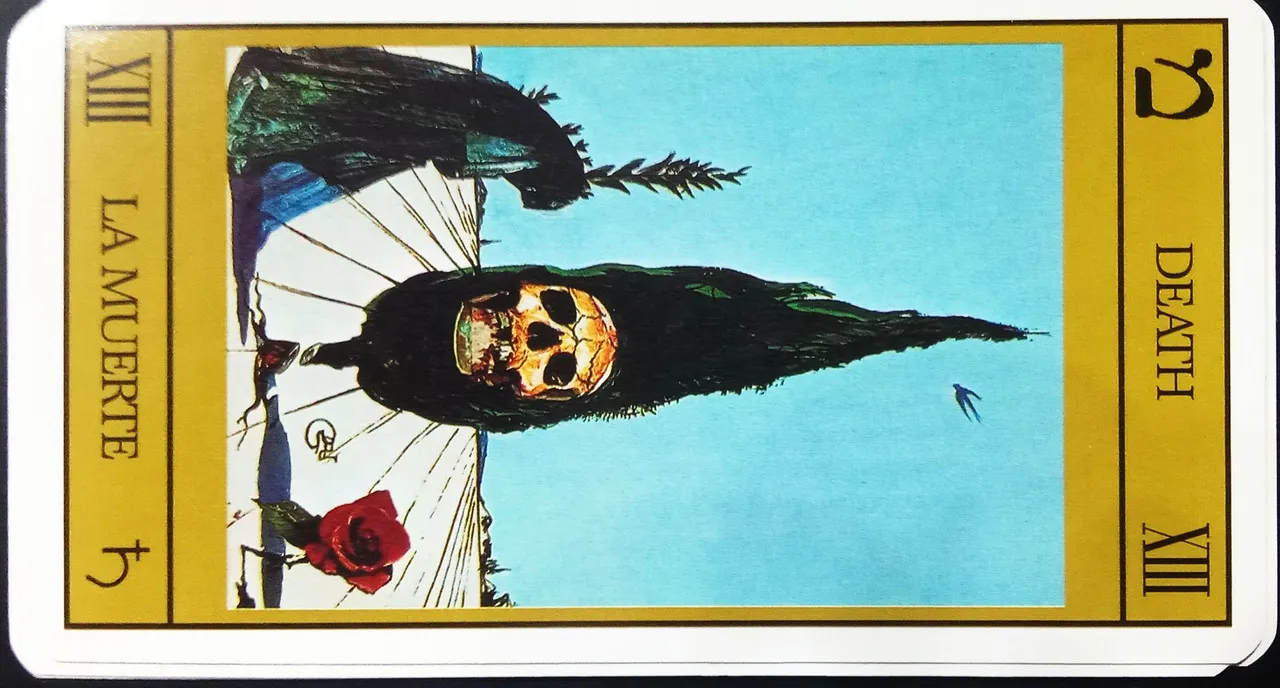
Su simbolismo alude a la renovación. Si no muere lo viejo no puede surgir lo nuevo. En alquimia, el quinto elemento (el mercurio) se logra con la “boda” de los contrarios, logrando una unidad superior. Es el arquetipo de la transformación. Quitar de la mochila la carga innecesaria, el “tártaro”, y tomar del loco y del emperador aquello que nos sirve para avanzar.
Falstaff : ¡Dime! ¿habrá horcas en Inglaterra cuando seas rey?Príncipe de Gales: No, ese cargo te lo reservo a ti,
serás un buen verdugo.
La crisis de la adolescencia
El resultado final de la crisis adolescente puede ser el conformismo, la repetición de lo heredado o, al contrario, el camino de la espontaneidad y de lo nuevo, es decir, el comienzo de un camino propio. Es una etapa llena de peligros en la cual las decisiones que tomamos van a influir de forma enorme en nuestra vida futura. Tan peligrosa es esta etapa, que estar perdido se puede confundir con ser libre.
No voy a desvelar el final del film, pero no podríamos entender la resolución a este conflicto de identidad, tan propio de la adolescencia, sin comprender que tanto el padre (la ley) como Falstaff (la espontaneidad) habitan dentro del joven príncipe. Será su responsabilidad la de convertirse en un tirano como su padre, convertirse en un “loco” como Falstaff o seguir su propio camino, siendo flexible y recogiendo lo más positivo de cada modelo para cada momento de la vida.
En este sentido, Enrique IV y Falstaff seguirán vivos en el futuro rey, por identificación, aunque éstos desparezcan de la realidad, aunque mueran.

Analysis of the Triangle, Falstaff, Prince Hal and Henry IV (the King)
Hal, the Prince of Wales, is a rebellious adolescent, like so many, who is only looking for his own identity, to differentiate himself from others, also from his father and from parental mandates. In this crisis, the young man lives in the midst of two opposing energiess, as we shall now see.
Let no one be frightened by what is to come.
To analyze this triad, today I will take the help of the major arcana of the Tarot. Not as a divinatory tool, but as representations of the universal archetypes of which Jung (1875-1961) spoke.
The Emperor

It is the archetype of the Father, of the Law. Of the control of our passions. It represents the moral conscience. Inverted represents vanity, tyranny, vulgar materialism. It represents the necessary delay of immediate satisfaction in order to achieve higher goals.
Any human being who wants to achieve a goal should postpone the immediate satisfaction of any desire in order to achieve higher goals and satisfactions. For example, if a student wants to get good grades he will have to sacrifice things that surely make him happier than studying, such as going out to parties, in order to achieve his goal.
The King talks about his son, the Prince of Wales:
The Prince of Wales and I
must speak in private
I do not know whether it is for some fault
that I committed for what God willed to do
to bring forth from my blood the evil that will give sorrow to
all my miseries.Tell me if not .how such low desires, such lowly
such base desires, such base pleasures, such impure pleasures, such
accompany the greatness of your blood?
The Fool

The Fool represents the force of the unconscious. It is the energy that pushes us to go beyond the rules, beyond the established. It connects us with our inner child, with intuition, with curiosity.
In its negative aspect it indicates immaturity, being carried away by immediate satisfaction. It is impossible to achieve our dreams without sacrifice, without sacrificing small pleasures in exchange for achieving our goals. We continue with the example of studies. Without studying, which means sacrificing immediate desires, it is impossible to get a university degree.
John Falstaff: when thou art king let us not be called robbers of the beauty of the day, since by night we walk, but rangers of Diana, knights of the shadow, let it be said that we are good people since as brothers we are ruled by our fair and chaste Moon under whose face we steal.
The lovers

It represents free will, the choice between two opposites, good or evil, vice or virtue.
This card represents free will, the choice between two opposites, good or evil, vice or virtue.
The prince is between two forces and it is time to make a momentous decision. Repeat patterns or take a path of his own. In this context, this card represents the finding with one's own identity.
Prince of Wales: The day I put an end to this mad living and pay a debt I never contracted, the astonishment of my subjects will be greater and my reform, so unexpected, will shine attracting all and will be more admired than a virtue that nothing makes stand out. My change, after my faults, will be more meritorious.
Death

Its symbolizes renewal. If the old does not die, the new cannot emerge. In alchemy the fifth element (mercury) is achieved with the "wedding" of the opposites, achieving a higher unity. It is the archetype of transformation. To remove from the backpack the unnecessary burden, the "tartar", and to take from the madman and the emperor that which serves us to advance.
Falstaff : Tell me! will there be gallows
in England when you are king?
Prince of Wales : No, that office I reserve for you,
you will be a good executioner.
The crisis of adolescence
The result of the adolescent crisis can be conformism, the repetition of what has been inherited, or the path of spontaneity and the new, that is, the beginning of our own path. It is a stage full of dangers in which the decisions we make will have an enormous influence on our future life. So dangerous is this stage, that being lost can be confused with being free.
I will not reveal the end of the film, but we could not understand the resolution to this identity conflict, so typical of adolescence, without understanding that both the father (the law) and Falstaff (spontaneity) live inside the young prince. It will be his responsibility to become a tyrant like his father, to become a "madman" like Falstaff or to follow his own path, being flexible and gathering the most positive of each model for each moment of life.
In this sense, Henry IV and Falstaff will remain alive in the future king, by identification, even if they disappear from reality, even if they die.


Imágenes y separador editadas con GYMP:
Images and separator edited with GYMP:
Banner edited with Canva pro y recortado con ezgif.com.
Banner edited with Canva pro and cropped with ezgif.com.
SOURCE/FUENTE: Avatar created with AI Ideogram / Avatar creado con IA Ideogram

Prompt
silueta de aviador hecha con cordones blancos, poster, 3d render, conceptual art
Fotografías de mi propiedad realizadas con mi teléfono móvil Redmi A2 y editadas con pixlr.
Photographs of my property taken with my Redmi A2 cell phone and edited with pixlr.
Traducción al inglés DeepL de mi idioma nativo el español.
Translation into English DeepL from my native language Spanish.